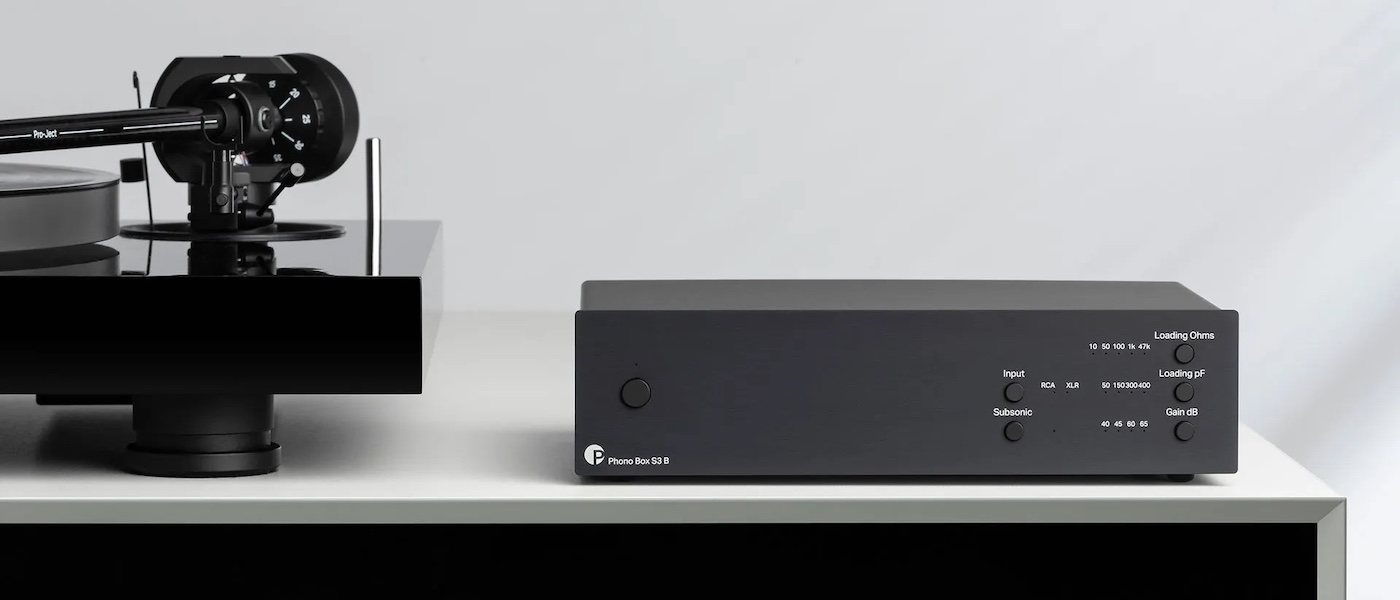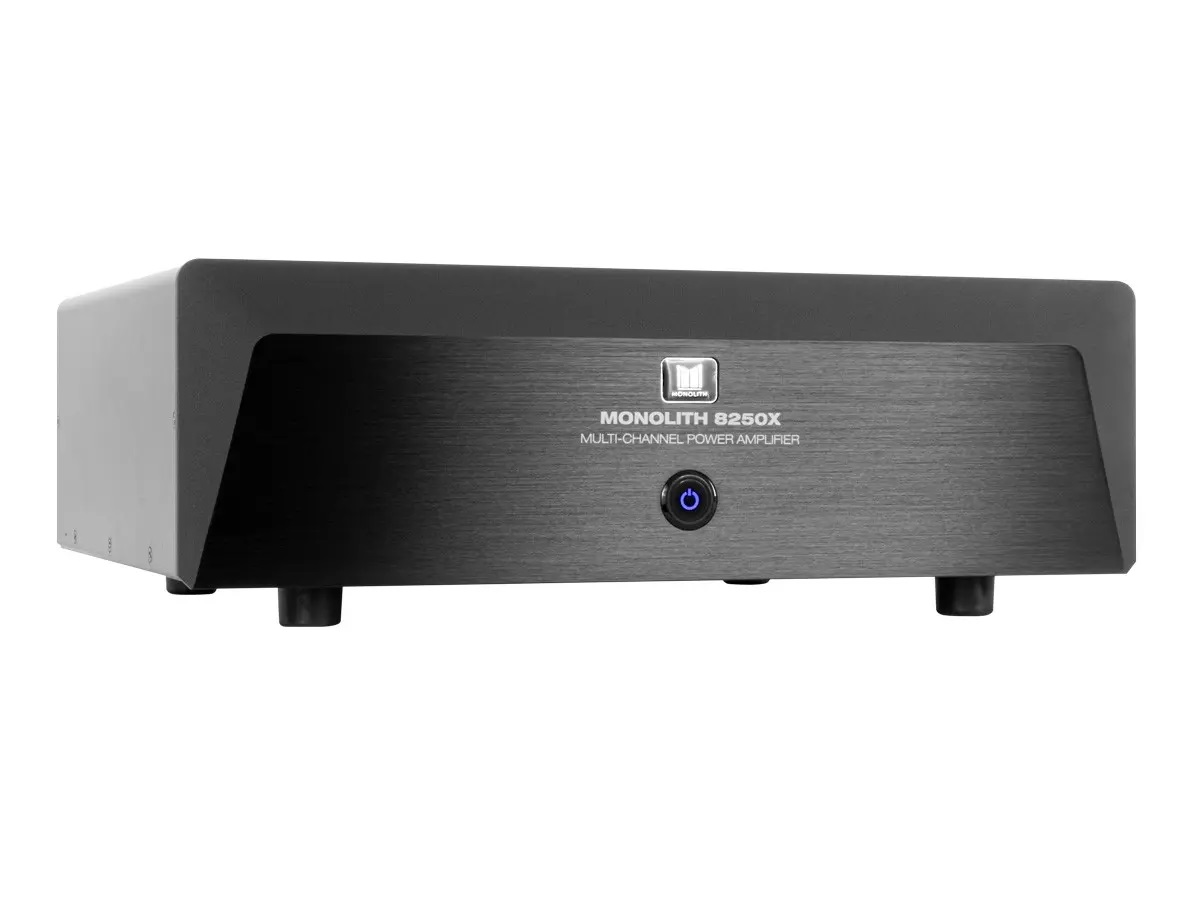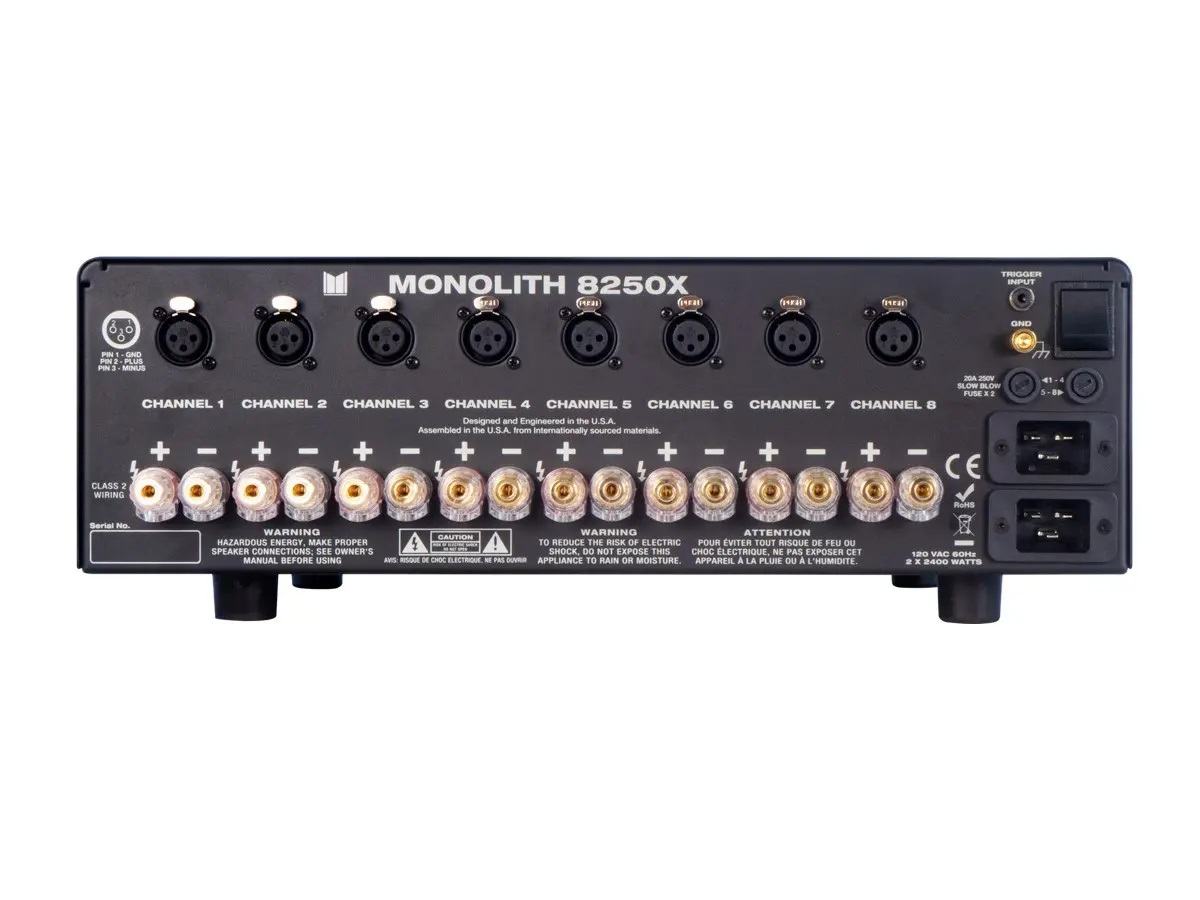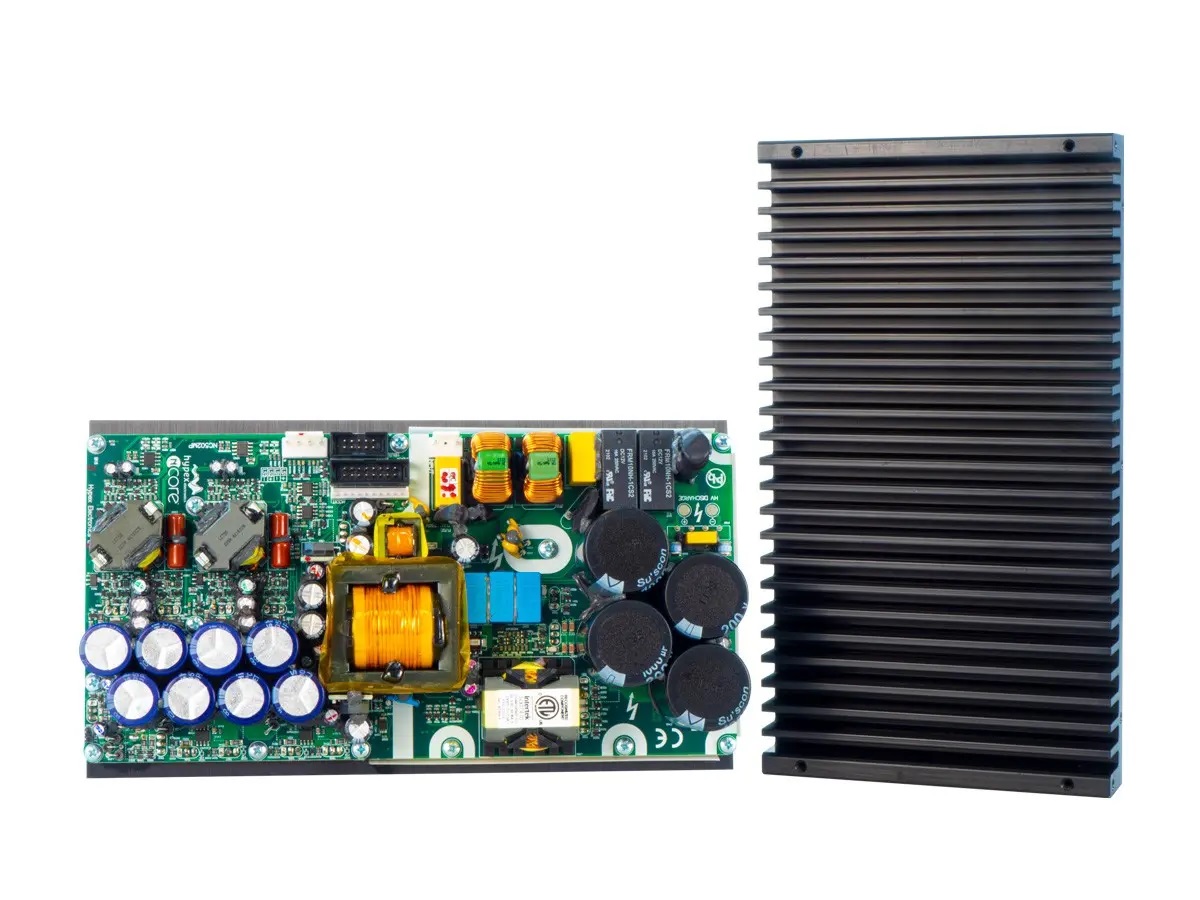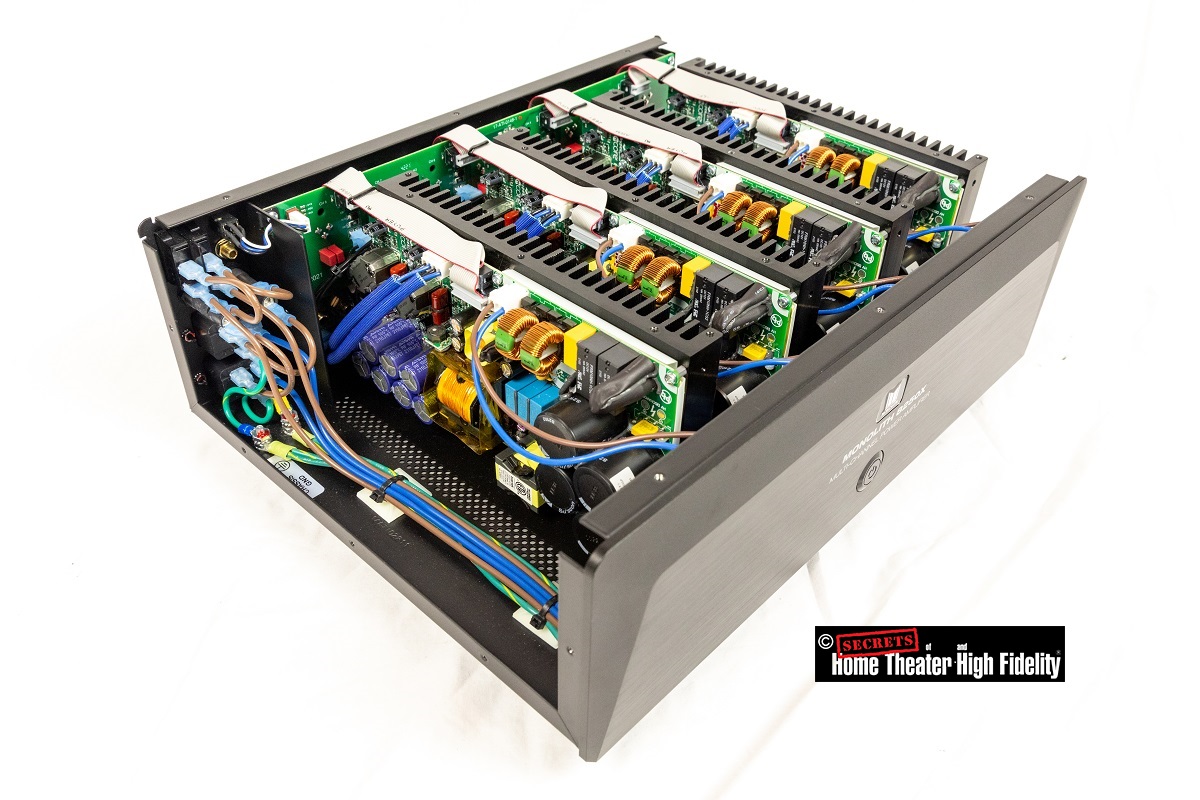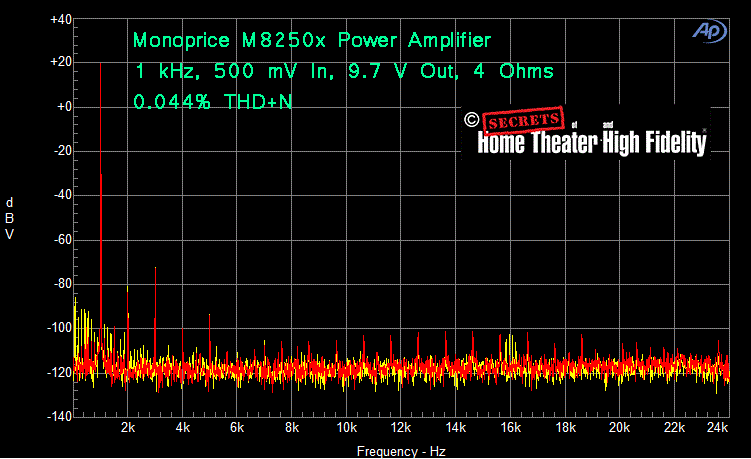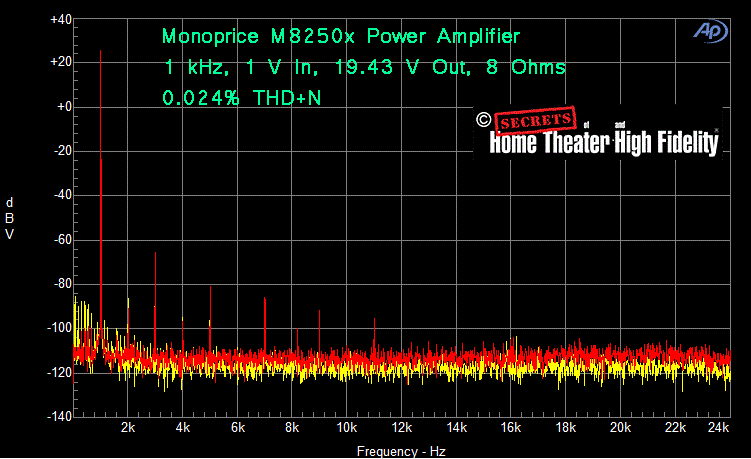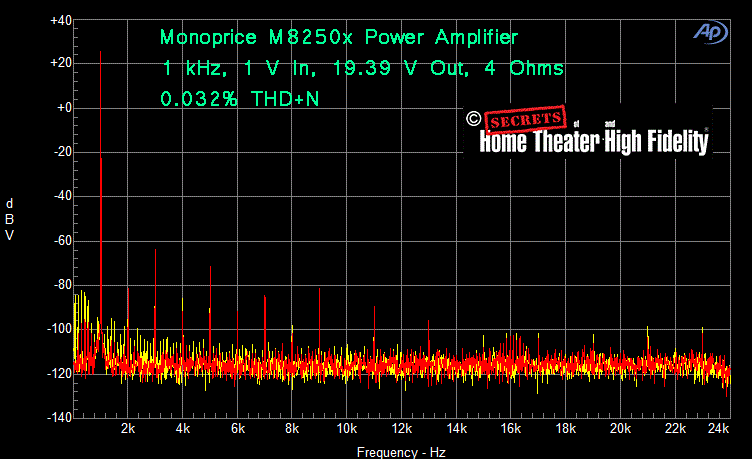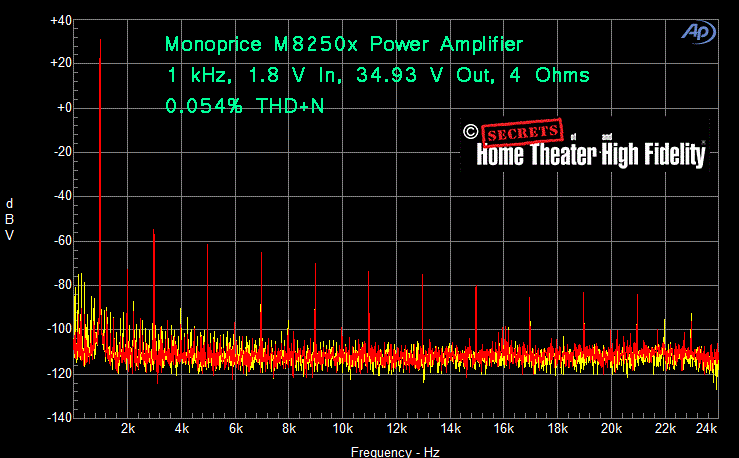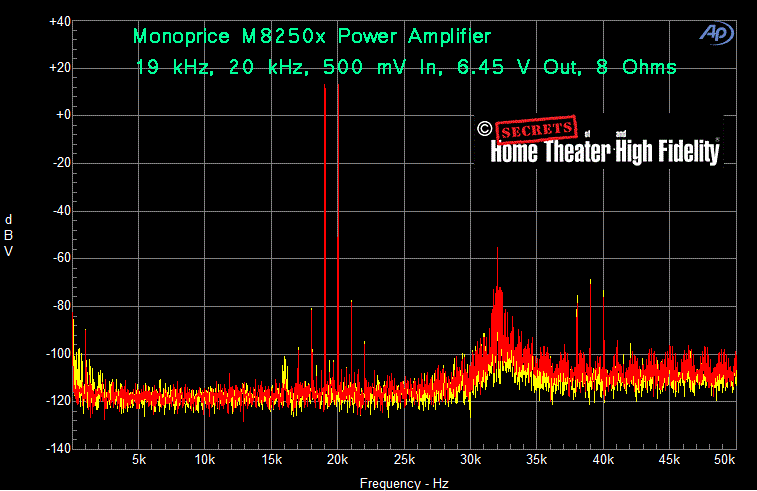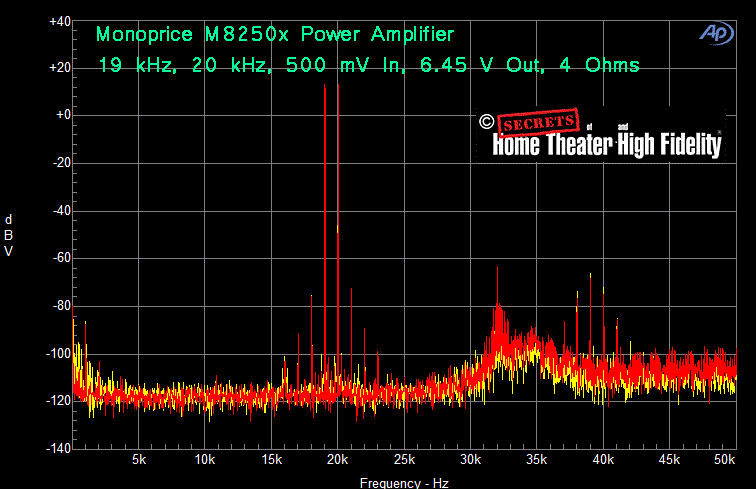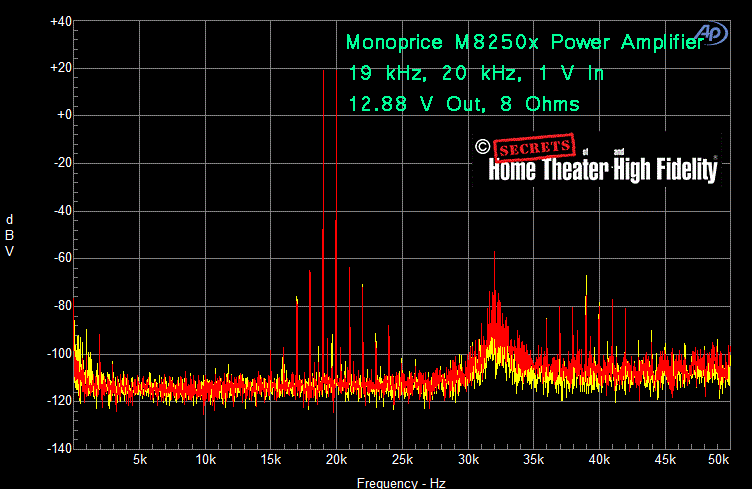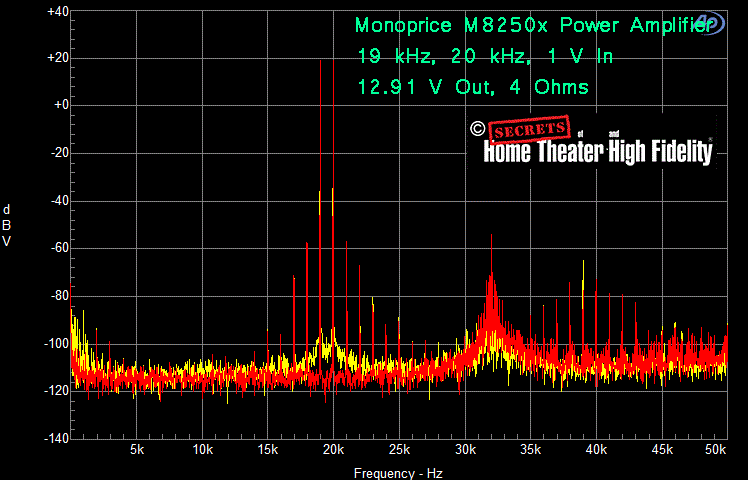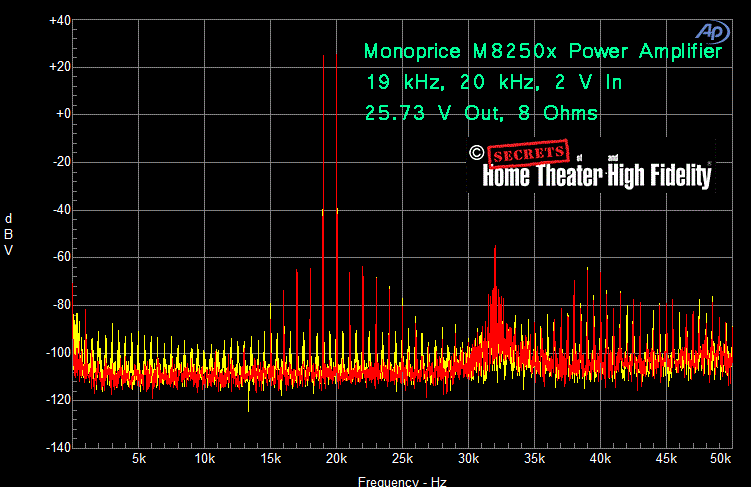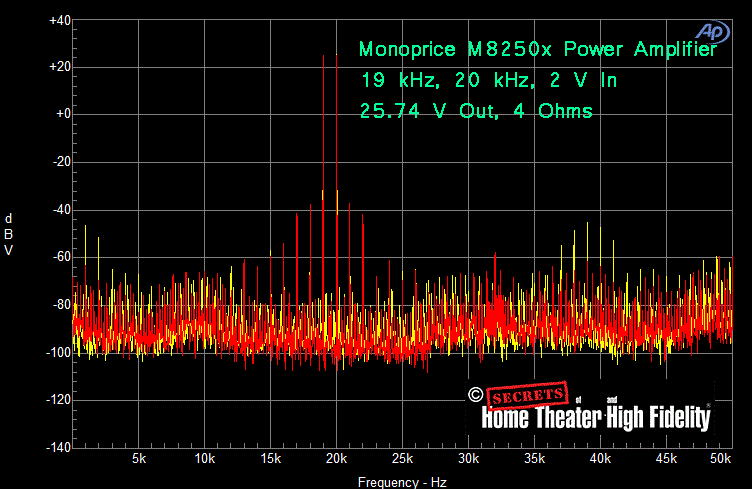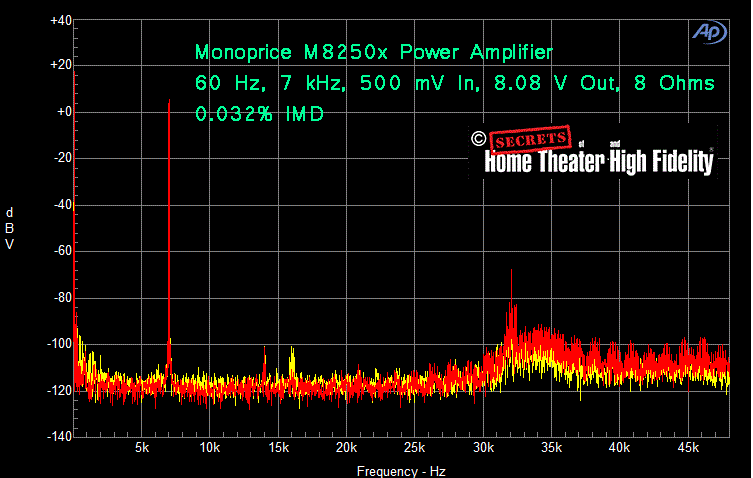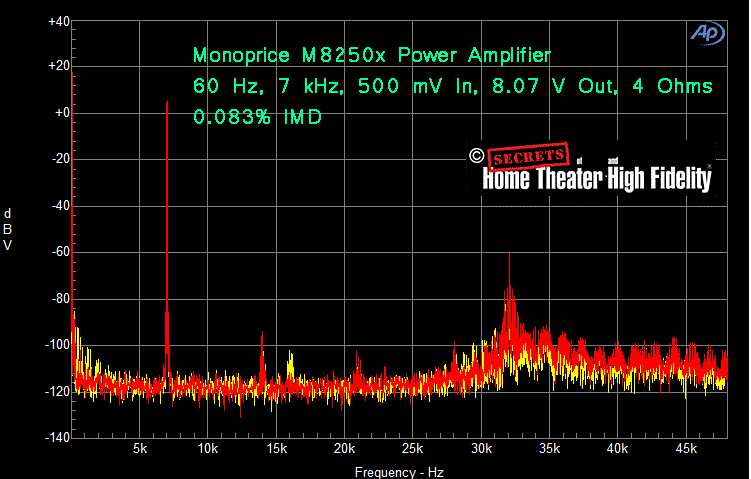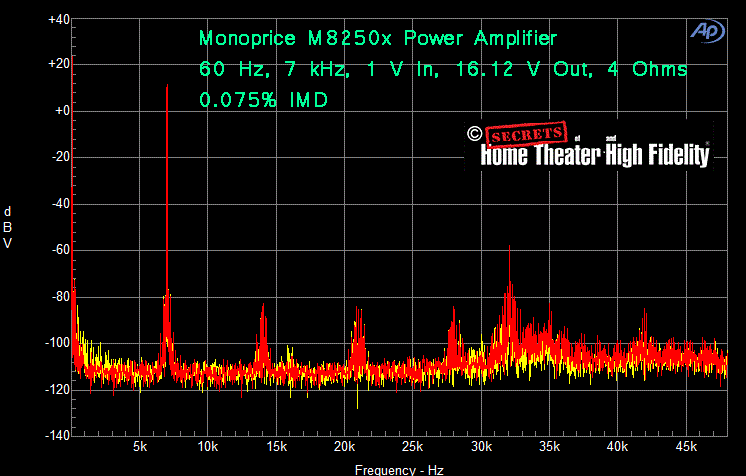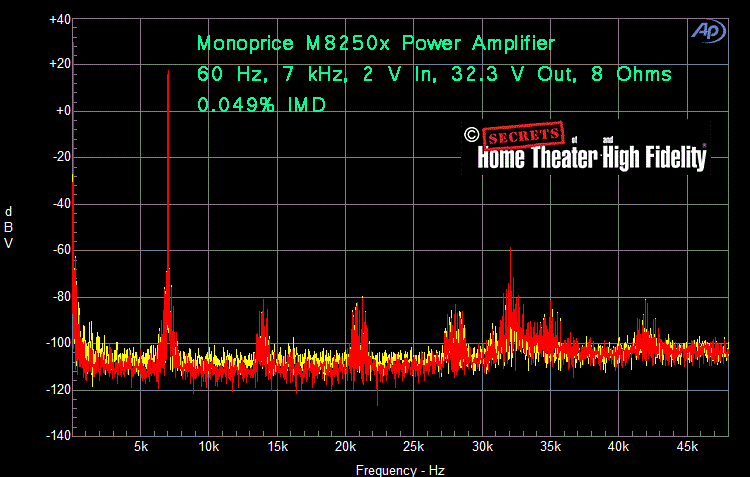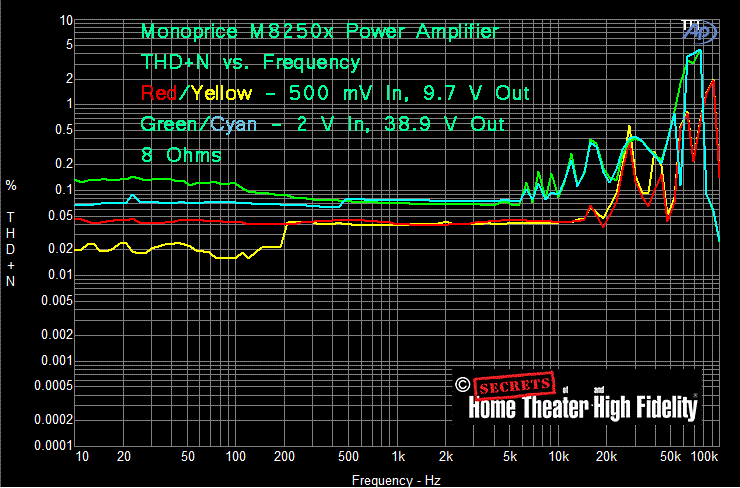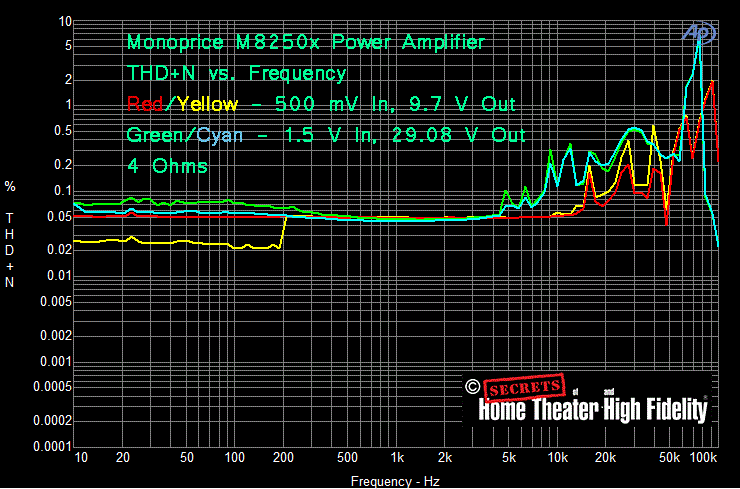Monolith by Monoprice 8250X
- Eight-channel Class D power amplifier with XLR inputs
- 200 watts per channel into 8 Ohms
- Hypex NCore NC502MP amp modules are 90% efficient
- Simple yet attractive design
- Small and lightweight chassis
- 5-year warranty
The Monolith by Monoprice 8250X loads eight channels of high power into a small and relatively lightweight chassis. Using Hypex NCore® Class D amplifier modules, the 8250X is incredibly efficient and doesn’t generate a ton of heat. Most importantly, the 8250X delivers exceptionally neutral sound with plenty of detail. It also retains a touch of musicality that pairs well with pretty much any multichannel system.
Monoprice has been a force in the internet-direct A/V and computer accessories world since 2002. Initially a source of high-value cables and other accessories, they have steadily increased their range of product offerings as the company has grown. In 2016, they decided to offer a higher-performance line of products under the Monolith by Monoprice label. Starting with speakers, cables, and headphones, the Monolith sub-brand has continued to grow and now includes many new products like subwoofers, a well-reviewed home theater pre-amp (the HTP-1), and numerous amplifiers. While Monolith’s first amplifiers were Class A/B designs, they have recently added their first Class D amps to the catalog; the eight-channel M8125X (8 x 125 watts) and the more powerful eight-channel M8250X that is the subject of this review. Loaded with the well-regarded Hypex NCore amplifier modules, the M8250X promises to deliver 200 watts of power across its eight channels.
Design:
8-channel power amplifier
Amplifier modules:
4 x Hypex NCore NC502MP
Power Rating:
200w x 8 @ 8 ohms, 400w x 8 @ 4 ohms, 20Hz-20kHz +/- 0.5dB
Power Supply Capacity:
4 x 1200w Surface Mount Power Supplies (SMPS)
Frequency Response:
20Hz-20kHz +/- 0.5dB at rated power, 10Hz-48kHz +0, -3dB (Hypex spec)
Input Impedance:
47 kOhms
Input Sensitivity for full rated power:
1.465 Volts @ 8 ohms, 2.07 Volts @ 4 ohms
Damping Factor:
>400 @ from 20Hz-400Hz
Voltage Gain:
25.7dB
Signal/Noise ratio:
>115dB below FTC Full Bandwidth Power
THD:
Less than 0.05% 20Hz ~ 5kHz and 0.5% 5kHz ~ 20kHz @ 8 ohm Rated Power, less than 0.1% 20Hz ~ 5kHz and 0.5% 5kHz ~ 20kHz @ 4 ohm Rated Power
Inputs:
8 x balanced XLR
Outputs:
8 pairs of 5-way binding posts
Control:
1 x 12V trigger in
Rack Size:
3RU
Dimensions (W x H x D including binding posts):
17.1 x 5.25 x 14.5”
Weight:
35.5 lbs.
Warranty:
5 years (parts and labor)
MSRP:
$2,999.99
Website:
Company:
SECRETS Tags:
Monoprice, monolith, m8250x, power amplifier, multi-channel amplifier, home theater, power amplifier reviews, amplifier reviews 2022, power amplifier reviews 2022
Monolith kept the design of the M8250X fairly simple, which goes hand-in-hand with their high-value approach. The main chassis is steel and is judiciously ventilated at both the bottom and top. The aluminum front panel has a subtle trapezoidal design tapered into its brushed black finish. This gives the M8250X a modern, yet elegant look. While it may not be up to the “audiophile jewelry” level, it is certainly attractive in an understated way. A round power/standby button sits centered towards the bottom of the front panel and is surrounded by a blue LED light ring. The ring blinks during the startup process and then turns a solid blue once startup is complete. It will also flash to indicate any module failures within the amplifier.
Unfortunately, there is no way to dim or turn off the blue light so it could be a bit annoying in a blacked-out theater. The Monolith logo and white text identifying the model number complete the front panel aesthetic. The back panel has balanced XLR inputs for each of the eight channels. The XLR inputs are mounted directly to the chassis/back panel, which gives them a very solid feel when connecting or removing cables. A single 12V trigger input, beefy master power rocker switch, ground connection, two 20A fuses, two IEC C20 power inlets, and eight pairs of sturdy-feeling five-way binding posts round out the remaining back panel features.
Another nice touch is the silk-screened wiring diagram for the M8250X’s XLR inputs showing the pin layout. On the bottom of the chassis, four tall rubber feet ensure that you get a full inch of clearance beneath the amplifier to ensure adequate airflow through the vents in the bottom of the chassis. Overall fit and finish were excellent, with the amp feeling extremely solid. Considering that the M8250X is manufactured for Monoprice by ATI right here in the US of A, the fantastic build quality didn’t surprise me. Monoprice doesn’t even try to hide their outsourced manufacturing, with some of the included paperwork clearly stating “Amplifier Technologies Inc.” ATI has a fantastic reputation in the OEM world, so I’m glad to see that Monoprice picked such a great partner for the M8250X. Monoprice shares this confidence as they back the M8250X with a 5-year warranty, which is pretty much unheard of with A/V equipment today.
Moving inside, there are four Hypex NCore NC502MP modules. Each module drives two channels at 200 watts per channel into 8 ohms or 400 watts per channel into 4 ohms. Unfortunately, you cannot bridge the modules for more power. A single Hypex 1200-watt SMPS (Switched-Mode Power Supply) feeds power to each of the four modules. Two SMPS modules are tied into each of the two IEC power inlets which then power channels 1-4 and 5-8 respectively. Both power cords must be connected to the amp for it to function. Monoprice recommends connecting the M8250X to two separate 20-amp outlets if you want to get the full-rated 4-Ohm output to all eight channels. 15-amp circuits will also work but will not have the ~46 amps of current needed to reach the full rated output at 4-Ohm loads.
Many of the other eight-channel NC502MP-based amps on the market only have a single power line input, so I’m curious how they can even come close to the NC502MP’s rated power levels if you have 110v power outlets as we have here in the US. Monolith has also gone the extra distance with the NCore modules themselves. Instead of just slapping them into the chassis, they have added custom-designed heatsinks to the back of each one to keep the components cooler and create a greater surface area for heat dissipation. The NC502MP modules are then mounted upright in the chassis, which allows the edge of the heatsinks to attach to the chassis cover. This effectively extends the heatsinks’ surface area to the top chassis panel, further improving heat dissipation.
All this passive heat management means that there are no fans inside the M8250X, which allows the amp to operate in complete silence. I removed the M8250X’s cover plate to take a peek inside and was very impressed with what I found. To start, all the screws in the amp’s chassis cover were countersunk, which is always a sign of attention to detail. As you can see in the pictures below, the wiring is clean and neatly routed. The four SMPS modules are mounted towards the front of the chassis, away from the amplifier modules. The heatsinks on each module are very robust and line up with the holes in the top and bottom of the chassis to ensure that the maximum amount of air is reaching the large heatsink fins. The heatsinks also screw into the bottom chassis plate, which adds even more surface area for heat dissipation. Overall, the wiring and board layout looked very well thought out. Monolith even publishes a full set of Audio Precision measurements of the M8250X on their website, which is rare in today’s market.
The Monolith M8250X Amplifier arrived at my home in a sturdy box and was protected by two layers of dense foam. Unpacking was easy, as it weighs less than 36 pounds and is very small for an eight-channel design. As I was simply substituting it for my reference Wyred4Sound multi-channel Class D amp, all I had to do was swap the seven XLR signal cables, seven speaker cables, and 12V trigger cable from my existing setup over to the Monolith. Note that the M8250X does not include a 12V trigger out, so if you use multiple amps in your setup, you cannot daisy-chain a 12V signal from the M8250X to another amp. If your pre/pro has multiple 12V trigger outs (most recent ones do), this won’t be an issue in a larger system. There are also 12V compatible splitters you could use in a pinch. Another sign of the M8250X’s attention to detail is how the XLR inputs are at the top of the chassis while the speaker connections are located along the bottom. Since most amplifiers tend to be installed towards the bottom of an equipment rack with the pre/pro mounted above (at least in my experience), this makes for neater cabling. Make sure to connect your front three channels to different modules to ensure they have access to the most power/current. I also hooked up my main left and right channels in such a way as to tap into the two separate power inlets when listening to pure two-channel stereo. This was my final channel mapping:
- Front Left = Channel 1
- Left Back Surround = Channel 2
- Center Channel = Channel 3
- Front Right = Channel 5
- Right Back Surround = Channel 6
- Left Surround = Channel 7
- Right Surround = Channel 8
This left channel 4 unused, allowing the center speaker to get maximum power from SMPS #2. While my reference amp uses dual power cords with standard three-prong IEC sockets, the M8250X uses the less common IEC C20 horizontal inlet. Fortunately, Monoprice includes two C19 cables in the box, so I just swapped those out as well. The M8250X was used in my 7.2 media room setup, which is controlled by a Marantz AV8801 pre/pro. Source components included an Xfinity cable box, Oppo UDP-205 UHD disc player, Xbox Series X, and Amazon FireStick 4K Max for streaming duties. Connected speakers were Sonus faber Olympica IIIs in the front positions, an Olympica Center for center channel duty, Olympica Is for surrounds, and Sonus faber Venere Walls for the back surrounds. My two Hsu subwoofers filled in the deep bass.
Secrets Sponsor
With everything connected, I flipped the main power switch on the back of the amp to its on position and then pushed the front panel standby switch on as well. Now, the M8250X could respond to the 12V trigger signals from my pre/pro. The M8250X includes soft start turn-on circuitry, which protects the amplifier from blasting any loud signals at startup. It also checks each NCore module for faults during the startup process, which you will hear as a few clicks. This self-check completes in about five seconds and then you are ready to go.
Secrets Sponsor
My reference amp has different power levels between the front (~1050W @ 4 ohms) and the surround channels (~525W @ 4 ohms) so before doing any critical listening, I ran a fresh Audyssey Pro calibration on my Marantz AV8801. This ensured that I had the levels matched properly for the M8250X’s equal-power channels. Unless specifically stated, I used Marantz’s Pure Direct mode to disengage all Audyssey processing and EQ during my listening sessions. This ensured that I was judging the raw sound of the M8250X versus what Audyssey was doing to correct my room’s issues. I also gave the M8250X about 250 hours of burn-in time by running music in all-channel stereo mode before any critical listening. This was probably unnecessary, as I didn’t detect any noticeable change in the amplifier’s tone versus the first time, I fired it up. I did find that the amp sounded just a touch smoother after 10-15 minutes of run time, but the differences were so subtle that they could have just been in my head. The heat was never an issue either. Even after running the M8250X at a fairly high volume for over 10 hours during one all-channel break-in session, the top of the chassis only got up to 115 degrees.
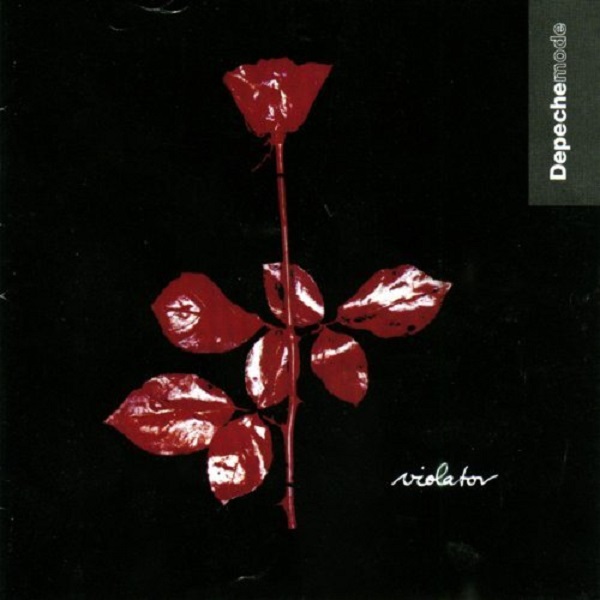
Depeche Mode “Violator”
As I wanted to really test the abilities of the M8250X, I started up my listening sessions with some high-quality lossless multi-channel music. Depeche Mode’s “Violator” is one of my favorite and most demanding multi-channel tests, so I queued up the DTS 96kHz/24-bit mix from the special DVD disc release (Warner B01A9KDD9A). “Sweetest Perfection” gave me a great window into the M8250X’s abilities. Right from the start of the track, the vocals had a sense of purity and accuracy that I don’t always experience with an audio component.
The musical background was absolutely silent with the M8250X, which really made the sound jump out at me. The synthesizer effects that bounce around the surround channels had this same “rightness” to them, which really immersed me in this hauntingly beautiful song. The imaging of the vocals was exceptional as well, with Martin Gore’s voice seeming to float in space between the left and right speakers. “Personal Jesus” is a more dynamic mix and carries even more sound to each channel. The M8250X proved up to the task, even when I increased the volume level over the 95db mark. The amp didn’t struggle at all, retaining its control and neutrality across all seven channels. The Bass remained perfectly balanced and punchy. The subtle effects of this great song were easy to hear and spread seamlessly throughout the sound field. The M8250X helped pull me into the fantastic mix and I found myself listening to nearly the entire album. With my current equipment, this is the best I’ve yet heard “Violator” sound in my room.
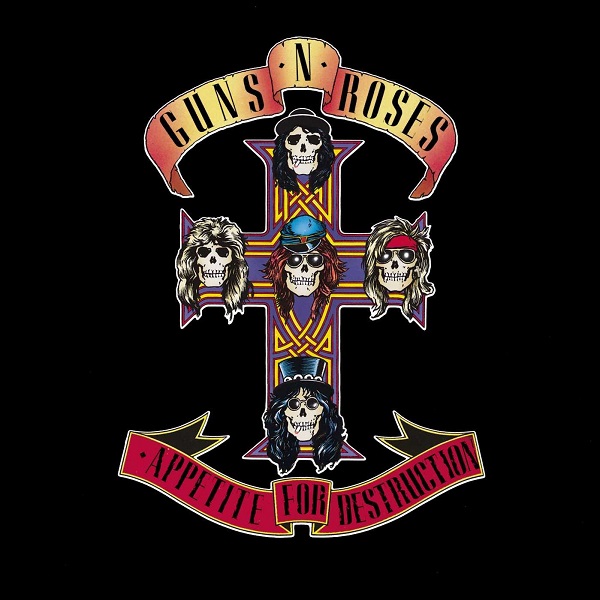
Guns ‘N Roses “Appetite for Destruction”
Guns ‘N Roses “Appetite for Destruction” (96kHz/24-bit 5.1 DTS-HD Master Audio, Blu-ray, Universal B07CPDVQYW) was a revelation in terms of clarity through the M8250X. This new surround mix (sadly only available by buying a large and expensive box set) separates the raw elements of this fantastic album and spreads them throughout the different channels. This makes the lead and rhythm guitar tracks far more distinct and easier to follow. For a guitar player like myself, this means that you can hear not only the individual notes of both Slash’s lead line and Izzy Stradlin’s rhythm parts but how they play those notes.
The intro of “Sweet Child o’ Mine” sounded amazing, with Slash’s Les Paul (or should I say Les Paul clone) singing with an incredibly sweet tone and the accompanying acoustic guitar lines sounding tonally realistic. Izzy’s clean electric parts had excellent fullness, shimmer, and sparkle without any hint of harshness. Axl’s vocals were delivered with a purity that I’d never heard through any prior two-channel releases of “Appetite.” While this multi-channel mix is not too heavy on the bass, the M8250X delivered the mid-bass with great punch and tightness. The M8250X’s overall presentation was certainly better than my reference IcePower Class D amp, with a more natural midrange and far more detailed and extended treble.
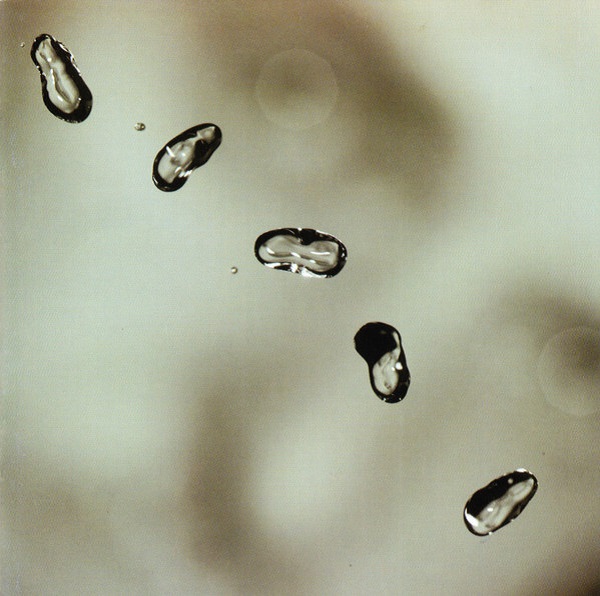
Peter Gabriel “Up”
Peter Gabriel’s multi-layered sound really lends itself to surround sound mixing, and his latest album, “Up,” (SACD 5.1) continues that tradition. While there are a lot of standouts on this disc, “Growing Up” is probably my favorite. “Growing Up” starts off quietly with soft vocals from Gabriel surrounded by ethereal backing tones coming in from the surround channels. The song kicks in with force right around the 1:11 mark with pounding electronic bass notes and synthesizers. The sound comes at you from all channels and the M8250X really delivered the raw power and dynamics captured in the mix. This is a very well-recorded album and the M8250X just reproduced what was on the disc without embellishment. Once again, I found myself simply enjoying the wonderful spaciousness and tonal purity of each little sound captured in this mix.

“PREY”
While I was totally impressed with the M8250X’s performance with musical material, I still spent a good amount of time with movie sources. The first full movie I watched was “Prey” via Hulu on my FireStick 4K Max. The last few “Predator” movies have been let-downs for me, but this one was surprisingly solid. The lossy Dolby Digital+ 5.1 sound was also better than I expected. Early in the movie, there is a scene where Naru gets bored gathering food and sneaks off into the woods to practice her hatchet throwing. Through the M8250X the sound of the hatchet burying itself in numerous tree trunks was incredibly crisp and clear, with the echo of each “thunk” reverberating through the surround channels. It really sounded like I was in the forest with her.
The scene where Naru is attacked by the bear was even more dynamic, with the sound engineers doing a great job with the bear’s grunts and growls while he tears apart the beaver lodge. The M8250X beautifully captured the “wooden” tone as branches fell upon each other along with the sharp cracks of breaking branches right until the Predator shows up and puts an end to the fight. There are numerous scenes where Naru is alone in the woods or grasslands and the M8250X’s ability to render fine detail like the sound of the wind through the trees or grass really made it feel like I was out there with her.

“Lightyear”
Next up was “Lightyear” on Disney+ (5.1 Dolby Digital+). The intro scene when they land on an alien world was a great test of the M8250X’s abilities. Everything starts off quietly enough but then gets loud once the alien plant life attacks. The fight to get back to their spaceship had lots of cool laser blasts and the “laser machetes” sounded neat when they cut through the plant tentacles. These details were exceptionally clear through the M8250X. Of course, the best part was the take-off of their spaceship and the ensuing crash, which engaged all the surround channels as well as the subs to great effect. Buzz’s first hyperspace test was also a sonic treat, with tons of dynamic bass during the spaceship launch as well as the near-hyperspace effects which filled the sound field.

“Top Gun: Maverick”
Right before I had to box up the M8250X, “Top Gun: Maverick” was released for digital download. While I had promised myself that I was going to hold out seeing this until my 4K Blu-ray (with a proper lossless Atmos mix) arrived, a family gathering provided the perfect excuse to pay for a 4k digital copy with the lossy 5.1 Dolby Digital+ Atmos soundtrack. Besides being one of the few sequels that I can remember that lived up to (and in many ways surpassed) the original film, “Maverick” is an absolute stunner from both an audio and video perspective. Even in lossless Dolby Digital+ form, the sound in this film was top-notch. From the introduction with the Top Gun theme playing to the transition to Kenny Loggin’s “Danger Zone” as the jets start to launch, the M8250X sounded great. Pretty much every single flight sequence is a demo-worthy scene, but I particularly liked the “Darkstar” flight test. From the take-off when the Darkstar jet blows past the security building (knocking its roof off) to the initial firing of the scramjet engines, this scene is just pure home theater fun. The great dynamics and power of the M8250X had my room pulsing with energy. Even more impressive were the more subtle sounds in the surround mix, like Maverick’s breathing through his face mask or all his grunts and noises as he approached Mach 10. I can’t wait for my UHD Blu-ray disc to arrive so that I can hear this surround mix in full lossless form.
Bench tests of the Monoprice 8250X were conducted by John E. Johnson, Jr., using an Audio Precision Model SYS-2722 Analyzer.
At 1 kHz and 9.7 Volts into 8 Ohms, THD+N was a bit less than 0.038%.
Reducing the impedance to 4 Ohms, distortion rose a small amount. The 3rd harmonic at 3 kHz is higher than the 2nd at 2 kHz.
Raising the output to 19.43 Volts into 8 Ohms (47 Watts), THD+N was 0.024%, which is lower than the measurement at 9.7 Volts output, but the distortion peaks are higher. The distortion number goes down because the noise floor remains the same
At 4 Ohms, distortion went up more than it did at 9.7 Volts output, because distortion tends to rise at higher output. This is normal.
At 189 Watts (38.91 Volts) output into 8 Ohms, which is close to the specification of 200 Watts, distortion was 0.069%.
At 2 Volts input to 4 Ohms, the amplifier clipped, so I reduced the input to 1.8 Volts. The output was 34.93 Volts, which into 4 Ohms, was 305 Watts. As you will see later in the bench tests, the amplifier is capable of delivering 300 Watts into 8 Ohms at 1% THD+N, which is above the 200 Watts specification. It will output 600 Watts into 4 Ohms, but this is at 1 kHz, which is the normal specification test for power output from an amplifier.
The 19 kHz, 20 kHz test for 500 mV input, 6.45 Volts output into 8 Ohms is shown below (below the table). There are two side peaks. Of interest is some spurious noise peaks centering at 32 kHz. However, this is beyond the range of hearing. You can also see some smaller spurious noise peaks about every 1 kHz starting at about 36 kHz. The noise floor is raised in this region to -110 dB, whereas it is -120 dB below 25 kHz. This is the kind of thing that occurs in switching power amplifiers, which the M8250X is.
The noise peaks around 32 kHz are probably aliasing frequencies caused by the switching frequency. There are also some noise peaks at 16 kHz which is one-half the frequency of the 32 kHz peaks. High-frequency ripples of the switching signal are resampled in the PWM section which makes PWM-residual-aliasing distortion (Pavan, S., Schreier, R., Temes, G.C., Understanding Delta-Sigma Data Converters, 2nd ed., Wiley, New York, 2017). (See also: Five-level class-D amplifier employing fourth-order continuous-time sigma-delta modulator, H. Pakniat, https://doi.org/10.1049/ell2.12004, 2021).
This might be alleviated in the M8250X by the use of a steep low-pass filter around 22 kHz. Otherwise, high-frequency noise can cause listening fatigue since tweeters can reproduce some of it. In fact, Monoprice’s THD+N measurements reflect the additional use of an AES low-pass filter at 22 kHz connected at the amplifier output. Their results are shown in the table below.
At 4 Ohms, there are three side-peaks next to the 19 kHz, 20 kHz sine wave test signals.
Increasing the output to 12.88 Volts into 8 Ohms, the number of side-peaks goes up again, to four.
At 4 Ohms, the number of side-peaks is five.
At 2 Volts input and 25.73 Volts output into 8 Ohms, there are a lot of smaller distortion peaks.
At 4 Ohms, the entire noise floor is raised, with an almost uncountable number of small distortion peaks. This is at 166 Watts output.
For Intermodulation Distortion (IMD), 60 Hz and 7 kHz sine waves are used in a 4:1 ratio.
First, 500 mV in and 8.08 Volts out, into an 8 Ohms load. IMD was 0.032%.
At 4 Ohms, 0.083%.
Higher voltage created more IMD.
1 Volt in, 16.15 Volts out. The IMD number is not much higher, but the graph shows more. This is the reason just presenting a number is not as illustrative as the actual spectrum.
At 4 Ohms, you can see the additional peaks surrounding the 7 kHz input signal even though the measurement number is actually a bit lower than the measurement at 500 mV input and 4 Ohms.
With 2 Volts in and 32.3 Volts output, 8 Ohms, IMD was 0.049%. Look at the peaks surrounding the 7 kHz input signal. That is the IMD. Peaks at 14 kHz 21 kHz, 28 kHz etc., are harmonics.
And, at 4 Ohms. In this particular test, I was unable to use a 2 Volts input to match the input I used at 8 Ohms. The amplifier went into protection mode. So, I reduced it to 1.3 Volts input.
For the Frequency Response measurement, I used 500 mV and 2 Volts input.
First, with an 8 Ohms load.
The response is down 1 dB at 20 kHz.
Notice that for the 38.9 Volts output (189 Watts), the amplifier shut down for a few seconds when it reached 60 kHz. That did not happen with the lower voltage (9.72 V) output. Switching amplifiers can have a difficult time at high frequencies.
At 4 Ohms, I reduced the high voltage to 32.98 V (272 Watts). The frequency response is about the same as it is at 8 Ohms, suggesting that the amplifier’s response is not load-dependent.
Using a THD+N vs. Frequency plot, one can see the difficulties at high frequencies more clearly.
Notice that at the higher voltage, the plot becomes more jagged at a lower frequency than it does with the lower voltage. And at 4 Ohms (second spectrum below), the jagged plot starts at even lower frequencies.
So, this amplifier is not well-behaved at high frequencies. However, also note that the distortion does not ever go above 0.4% in the audible band.
The M8250X is rated at 200 Watts per channel into 8 Ohms, but the test here shows that it produces 300 Watts at 8 Ohms using the 1% THD+N standard. The 200 Watts is at 0.1% THD+N.
At 4 Ohms, 600 Watts at 1% THD+N.

Like all switching amplifiers, the Monoprice M8250X has its issues, but it does produce a lot of power. However, I would suggest it be used with speakers that have an 8 Ohms nominal impedance, not 4 Ohms.
Eight channels x 200w (or 400w @ 4 ohms) of power for $2,999? That is a pretty good power to $$$ ratio. The M8250X also sounds fantastic with either two-channel or multichannel sources. Throw in the compact chassis and excellent build quality and the M8250X is a fantastic bargain in the home theater world. While there are other amplifiers on the market using the Hypex NCore® NC502MP modules, most of these are coming from smaller, independent builders. Some of these competitors may be a bit cheaper, but they aren’t backed by the support structure of a large company, nor do they have a 5-year warranty.
- Very solid build quality
- Plenty of available power
- Runs relatively cool
- Exceptionally black musical background
- Amazing clarity
- Detailed sound without any harshness
- Very tight bass response
- Clean, accurate midrange
- Excellent dynamics
- Very good imaging and sound staging
- Cannot bridge any of the channels for higher power output
- Cannot dim the front panel power/standby light
- Add a 12V Trigger Out/Relay
Class D amplifiers really have come a long way in a relatively short time. While earlier examples had numerous shortcomings (both audible and measurable), recent designs have fixed many of those issues and have dramatically improved the overall sound quality as well. The Monolith by Monoprice 8250X is a fine example of what a well-designed Class D amp can do. Despite my best efforts, I couldn’t hear anything that was less than excellent with the M8250X. The M8250X played back every source with incredible neutrality, exceptional detail, powerful dynamics, and great bass response. The treble was highly detailed but always remained smooth. Midrange purity was excellent, with vocals standing out as exceptionally natural sounding. Class D’s inherent advantages in raw power, efficiency, low heat, and small size only increase the M8250X’s appeal. For a multi-channel system, even one that values music reproduction as heavily (or even more heavily) than film soundtracks, I just can’t find anything negative to say about the performance of the Monolith by Monoprice 8250X amplifier. It is the best-sounding Class D amp I have had in my system thus far and more importantly the first one that I have connected with emotionally.


